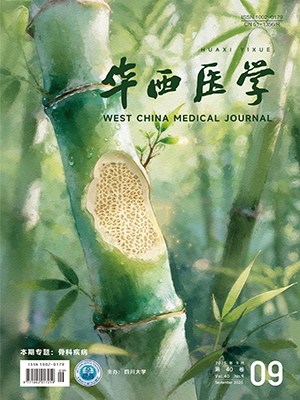| 1. |
孫西釗, 呂建林, 葉章群. 泌尿系感染性結石的病因和診治. 中華泌尿外科雜志, 2010, 31(2): 141-143.
|
| 2. |
Assimos D, Krambeck A, Miller NL, et al. Surgical management of stones: American Urological Association/Endourological Society guideline, PART Ⅱ. J Urol, 2016, 196(4): 1161-1169.
|
| 3. |
Kreydin EI, Eisner BH. Risk factors for sepsis after percutaneous renal stone surgery. Nat Rev Urol, 2013, 10(10): 598-605.
|
| 4. |
Draga RO, Kok ET, Sorel MR, et al. Percutaneous nephrolithotomy: factors associated with fever after the first postoperative day and systemic inflammatory response syndrome. J Endourol, 2009, 23(6): 921-927.
|
| 5. |
Bag S, Kumar S, Taneja N, et al. One week of nitrofurantoin before percutaneous nephrolithotomy significantly reduces upper tract infection and urosepsis: a prospective controlled study. Urology, 2011, 77(1): 45-49.
|
| 6. |
黎陽, 李文益. 彌散性血管內凝血病因 發病機制及其防治. 中國實用兒科雜志, 2013, 28(9): 669-672.
|
| 7. |
陳忠軍, 周家杰, 沈昊. 術中腎盂尿和結石細菌培養及藥敏試驗對預防經皮腎鏡取石術后尿膿毒血癥的價值研究. 中國全科醫學, 2020, 23(14): 1753-1759.
|
| 8. |
Margel D, Ehrlich Y, Brown N, et al. Clinical implication of routine stone culture in percutaneous nephrolithotomy-a prospective study. Urology, 2006, 67(1): 26-29.
|
| 9. |
Korets R, Graversen JA, Kates M, et al. Post-percutaneous nephrolithotomy systemic inflammatory response: a prospective analysis of preoperative urine, renal pelvic urine and stone cultures. J Urol, 2011, 186(5): 1899-1903.
|
| 10. |
Kumar S, Bag S, Ganesamoni R, et al. Risk factors for urosepsis following percutaneous nephrolithotomy: role of 1 week of nitrofurantoin in reducing the risk of urosepsis. Urol Res, 2012, 40(1): 79-86.
|
| 11. |
Mariappan P, Smith G, Bariol SV, et al. Stone and pelvic urine culture and sensitivity are better than bladder urine as predictors of urosepsis following percutaneous nephrolithotomy: a prospective clinical study. J Urol, 2005, 173(5): 1610-1614.
|
| 12. |
Sammon JD, Ghani KR, Karakiewicz PI, et al. Temporal trends, practice patterns, and treatment outcomes for infected upper urinary tract stones in the United States. Eur Urol, 2013, 64(1): 85-92.
|
| 13. |
Wang Y, Hou Y, Jiang F, et al. Percutaneous nephrolithotomy for staghorn stones in patients with solitary kidney in prone position or in completely supine position: a single-center experience. Int Braz J Urol, 2012, 38(6): 788-794.
|
| 14. |
Patel N, Shi W, Liss M, et al. Multidrug resistant bacteriuria before percutaneous nephrolithotomy predicts for postoperative infectious complications. J Endourol, 2015, 29(5): 531-536.
|
| 15. |
Sohn DW, Kim SW, Hong CG, et al. Risk factors of infectious complication after ureteroscopic procedures of the upper urinary tract. J Infect Chemother, 2013, 19(6): 1102-1108.
|
| 16. |
Nevo A, Mano R, Schreter E, et al. Clinical implications of stent culture in patients with indwelling ureteral stents prior to ureteroscopy. J Urol, 2017, 198(1): 116-121.
|
| 17. |
Mariappan P, Smith G, Moussa SA, et al. One week of ciprofloxacin before percutaneous nephrolithotomy significantly reduces upper tract infection and urosepsis: a prospective controlled study. BJU Int, 2006, 98(5): 1075-1079.
|
| 18. |
Rivera M, Viers B, Cockerill P, et al. Pre- and postoperative predictors of infection-related complications in patients undergoing percutaneous nephrolithotomy. J Endourol, 2016, 30(9): 982-986.
|
| 19. |
Wang Y, Jiang F, Wang Y, et al. Post-percutaneous nephrolithotomy septic shock and severe hemorrhage: a study of risk factors. Urol Int, 2012, 88(3): 307-310.
|
| 20. |
李天, 李遜, 江先漢, 等. 微創經皮腎鏡碎石取石術后SIRS患者進展為膿毒癥休克的預測因素. 中國老年學雜志, 2020, 40(2): 352-356.
|
| 21. |
McAleer IM, Kaplan GW, Bradley JS, et al. Endotoxin content in renal calculi. J Urol, 2003, 169(5): 1813-1814.
|
| 22. |
張媛, 楊林花. 感染性DIC研究進展. 血栓與止血學, 2006, 12(3): 140-142.
|
| 23. |
Wu H, Zhu S, Yu S, et al. Early drastic decrease in white blood count can predict uroseptic shock induced by upper urinary tract endoscopic lithotripsy: a translational study. J Urol, 2015, 193(6): 2116-2122.
|




